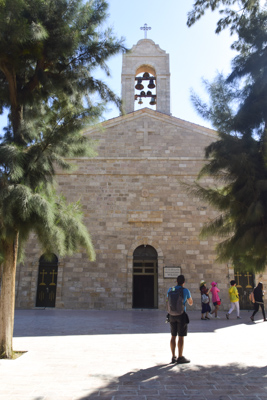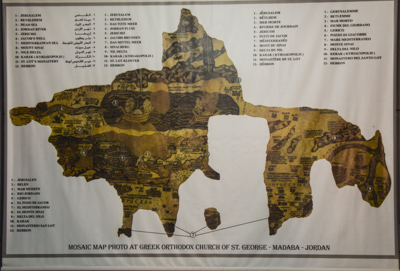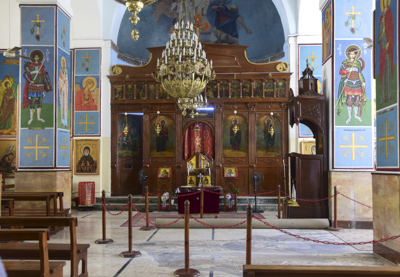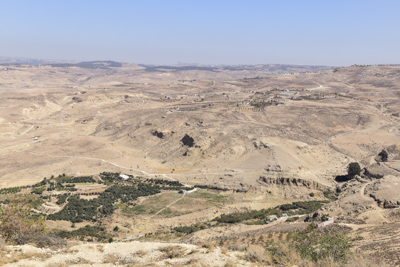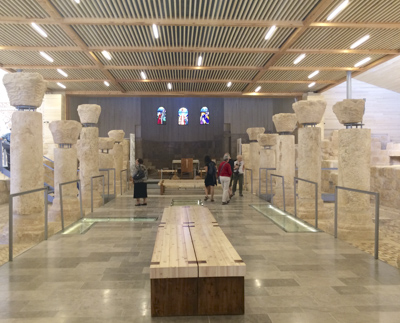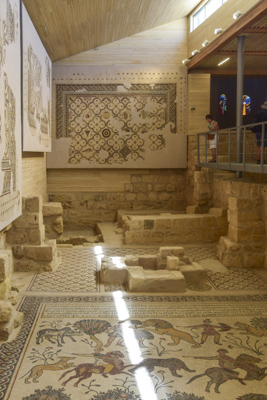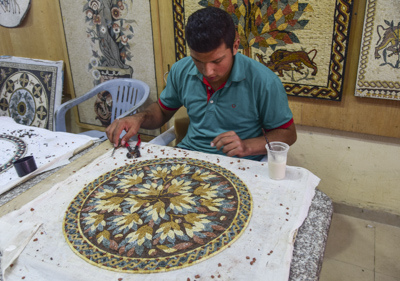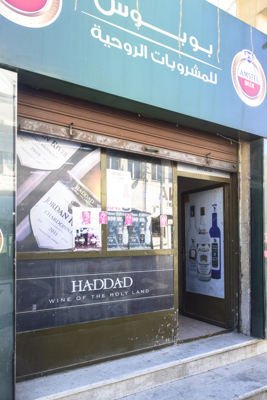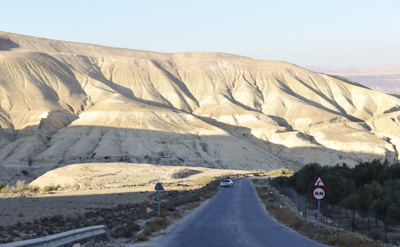Friday – September 29, 2017
Lobby of the Cham Palace Hotel in Amman, Jordan:
After breakfast we set off on our drive south along the King’s Highway. The road has been an international trade route for the last 5,000 years. Our first stop was the ancient city of Madaba, about 30 km from Amman, which is known for its beautiful Byzantine mosaics.
Madaba is known for the 6th century mosaic map of the Holy Land which is located in the Greek Orthodox Church of St. George. The “Madaba Map” is part of a floor mosaic and is considered to be the “oldest surviving original depiction of the Holy Land.” The photo below is an artist’s drawing of the map. Our tour guide, Muhammad, described the ancient symbols to us using this drawing.
The map depicts Jerusalem during the period from 542 to 570 AD. It was created by unknown artists for the Christian community of Madaba. Photo of the real map:
The interior of St. George’s Greek Orthodox Church is below. The mosaic map is enclosed on the floor within the red chains in front of and to the right of the main altar.
Less than 10 kilometers west of Madaba is Mt. Nebo, known as Pisgah in the bible. It is purported to be the place where Moses lived out his remaining days and viewed the Promised Land from a distance on top of the mountain.
The spectacular view from the summit provides a panorama of the Jordan River Valley, the West Bank city of Jericho, and on clear days, Jerusalem and Bethlehem.
Mount Nebo rises almost 2700 feet above sea level. Although it was a bit hazy, the Dead Sea was visible from the summit.
The plaque pictured below shows the distance and approximate locations from Mt. Nebo to many of the sites which my tour group and I will visit during the next few weeks.
The remains of a late 4th century Byzantine church and monastery were discovered on the Mt. Nebo summit in 1933. A modern chapel was built to cover and protect the site as well as the ancient mosaics. The original columns, mosaics, and walls were visible inside the chapel.
The chapel had been closed for renovation since 2007 and was reopened in 2016, so we were lucky to be able to visit this historic place.
We ate lamb stew, tabouli salad, hummus, and baba ganoush for lunch in a restaurant called the Terrace Souk. Afterwards Muhammad took us to a mosaic factory located nearby.
The handmade mosaics were lovely and several group members made purchases. Our next short stop was a liquor store because a few people asked about buying beer in Jordan. Stores that sell alcohol in the Muslim country are owned by Christians.
We stopped at a very sketchy looking shop and a few people purchased what they wanted. We learned it was 3 Jordanian Dinars for a can of beer with 8% alcohol.
We continued south on the King’s Highway through the Mujib Valley. This long meandering road has been the route of north-south trade and scenes of battles since prehistoric times and is mentioned in the bible.
The view out of the bus window reminded me of the drive through the Kyzylkum Desert in Uzbekistan. This was barren land as far as I could see with low hills of sand and stones.
Occasionally, there was a Bedouin village of shabby tents with enclosures for animals.
There were container trucks on the other side of the highway, driving north from the Jordanian millenniaport city of Aqaba on the Red Sea. The terrain became more hilly as we continued south and I wondered about the people who live on this rugged land and how they survive.
At four o’clock, we stopped for a break at a rest-stop which looked like a caravanserai. I paid mental homage to the traders, pilgrims, and Crusaders who passed through this region over the millennia while I enjoyed a refreshing ice-cream.
We drove down steep hills and around hair-pin turns to arrive at the Petra Moon Hotel as darkness settled onto the modern city of Petra.

